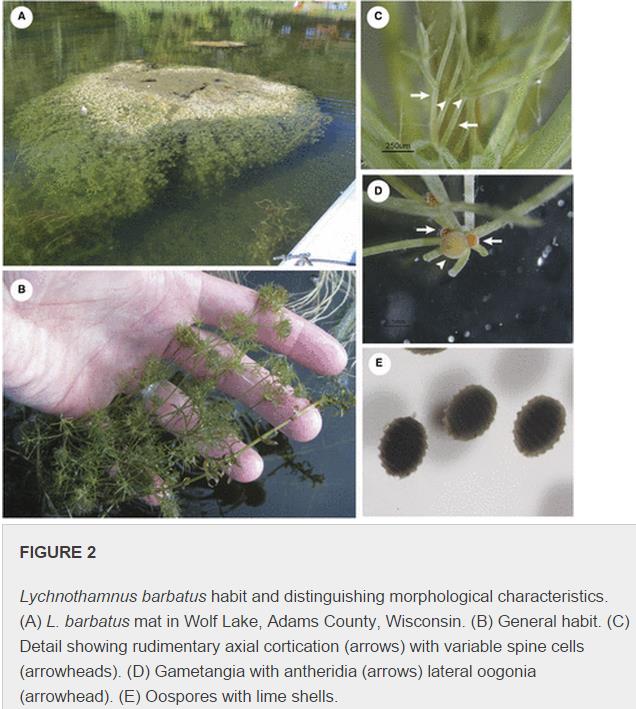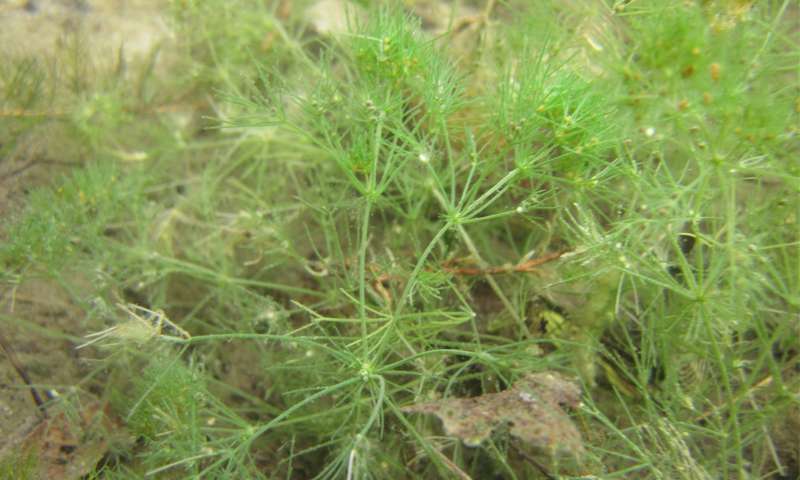博文
在北美首次发现存活的恐龙时代植物
|||
在北美首次发现存活的恐龙时代植物
诸平



FIGURE 3
Bayesian Inference phylogeny of Characeae based on three plastid-encoded loci. North American Lychnothamnus barbatus (shown in bold) are identical to European and Australasian specimens for these three loci. Lychnothamnus barbatus f.fasciculatus is also identical to L. barbatus f. barbatus. Lychnothamnus barbatus is most closely related to Nitellopsis obtusa. Nitella and Tolypella are both monophyletic while Lamprothamnium is embedded within Chara. Unlike previous analyses, the Nitelleae is monophyletic albeit with low statistical support.
据物理学家组织网(phys.org)2017年7月31日报道来自德雷塞尔大学(Drexel University)的消息,美国科研人员在北美首次发现了目前存活的恐龙时代植物——Lychnothamnus barbatus,相关研究结果已经在《美国植物学杂志》(American Journal of Botany)发表(可以免费浏览或者下载原文)——Kenneth G. Karol, Paul M. Skawinski, Richard M. McCourt, Michelle E. Nault, Reesa Evans, Martha E. Barton, Matthew S. Berg, Donna J. Perleberg , John D. Hall. First discovery of the charophycean green alga Lychnothamnus barbatus (Charophyceae) extant in the New World, American Journal of Botany, 2017, 104(7): 1108-1116. DOI: 10.3732/ajb.1700172.
Lychnothamnus barbatus是属于轮藻纲(Lychnothamnus (Charophyceae))植物,此植物之前被认为分布于欧洲和大洋洲的单型属,该类植物日趋衰落。在2003年有人发表文章指出:过去10年中 ,仅在澳大利亚昆士兰州华莱士湾发现数量丰富生长良好的Lychnothamnus barbatus (Meyen) Leonhardi。但是美国纽约植物园(New York Botanical Garden)、美国威斯康星大学斯蒂文斯·波恩特分校(University of Wisconsin—Stevens Point)、德雷克塞尔大学自然科学学院(Academy of Natural Sciences of Drexel University)、威斯康星天然资源部(Wisconsin Department of Natural Resources)、威斯康星州亚当县水土保持局(Adams County Land & Water Conservation Department)、密西西比州立大学(Mississippi State University)、威斯康星濒危资源服务处(Endangered Resources Services, LLC, St. Croix Falls, Wisconsin)、明尼苏达自然资源部生态环境和水资源处(Ecological and Water Resources Division, Minnesota Department of Natural Resources)的研究人员合作,经过实际考察研究首次发现了存在于北美地区的恐龙时代植物——Lychnothamnus barbatus,可以参见威斯康星大学保罗•斯卡温斯基(Paul Skawinski)提供的照片(Fig. 4)。

Fig. 4 Lychnothamnus barbatus. Credit: Paul Skawinski, University of Wisconsin Extension
对于此发现仿佛是你正在工作,突然一只猎豹在窗前通过。这就是理查德•麦考特博士(Richard McCourt, PhD,)和他的同事们当遇到Lychnothamnus barbatus时的感受。 Lychnothamnus barbatus过去一直被认为是在西半球(Western Hemisphere)猎豹灭绝之前很久就已经死亡的一种大型绿藻。但是,它的出现的确使人感到意外。
德雷克塞尔大学自然科学学院植物学副馆长(associate curator of Botany at the Academy of Natural Sciences of Drexel University)、德雷克塞尔大学文理学院(University's College of Arts and Sciences)教授理查德•麦考特博士说:“这意味着主要的是我们应该了解更多我们所不了解的东西, ‘Lychnothamnus barbatus’并非本身不存在,从生态学的观点来看,这的确是惊天动地的发现。它的发现改变了我们对北美藻类植物组成的已有看法,并激励我们去寻找更多的新发现。”
在 2012~2016年之间,研究人员从美国威斯康星州的14个湖泊以及密苏达州(Minnesota)的2个湖泊采集藻类样本。收集者知道在此之前他们在北美并未见过它,唯一的Lychnothamnus barbatus记录是在大西洋的西部阿根廷白垩纪时代的化石(Argentinian Cretaceous-era fossils),也发现了同期的霸王龙化石(Tyrannosaurus rex fossils)。
理查德•麦考特博士对于收集的样品协助鉴定,他说:“我们几乎立刻意识到我们可能要处理一些以前被认为灭绝的东西,因为它显然不同于北美看到的任何其他物种。但是我们不得不仔细确认,并提取其DNA来进行证实。”
就像猎豹一样, Lychnothamnus barbatus是目前在该地区发现相对罕见的植物。一种“轮藻纲植物”类型的藻类,众所周知是栖息于欧洲和大洋洲(包括澳大利亚、新西兰和巴布亚新几内亚等地)的藻类植物。
但实际上这个物种生长相对较高(有1英呎),而且有相当不同的形状。但是为什么它会被错过了呢?理查德•麦考特博士解释是“我们可能并未错过它,它可能就是一种新的入侵者。”既然是一种入侵植物,那么其入侵之旅为何不是北美而是中西部地区呢?麦考特说:“它可能像其他物种一样是通过船舶上的压载水带来的,释放到圣劳伦斯航道或其他湖泊。”不过,也有可能残留的Lychnothamnus barbatus一直就在这里,我们只是不知道罢了。
“如果它过去一直未引起人们注意,这可能是由于在湖泊和溪流的大部分地区对其一直尚未彻底检查所致,尽管对于藻类的样本收集已有数百年之久,”理查德•麦考特博士说,“我们需要脚踏实际、深入实际去采集更多的样本。”
虽然在中西部采集到Lychnothamnus barbatus样本的地点有16个,但是,也不能排除有可能这种恐龙时代的植物在北美的其它地区幸存下来,繁衍生息延续至今。
“我们正在密切关注,但它的栖息地与我们在美国收集的其他已知轮藻纲植物物种的栖息地没有什么不同,”理查德•麦考特博士说,“如果它存在,我们将会在适当的地方发现。问题就在于我们并不知道适合的地方在何处。”更多信息请注意浏览原文或者是相关报道:
Rare tooth find reveals horned dinosaurs in eastern North America
Lychnothamnus barbatus — a green alga
ABSTRACT
PREMISE OF THE STUDY: Although some species of Characeae, known as stoneworts, can be found on every continent except Antarctica, many species and some genera have limited geographic distributions. The genus Lychnothamnus, represented by a single extant species L. barbatus, was known only from scattered localities in Europe and Australasia until it was recently discovered in North America.
METHODS: Morphological identifications were made from specimens collected in Minnesota and Wisconsin, USA. DNA sequences were obtained for three plastid-encoded genes (atpB, psbC, rbcL) from seven putative Lychnothamnus samples from two states in the USA Distribution and abundance were estimated in each lake using point intercept surveys where surveyors sampled aquatic vegetation.
KEY RESULTS: Fourteen lakes in Wisconsin and two lakes in Minnesota, USA, were found to harbor Lychnothamnus barbatus. These represent the first report of this rare charophycean extant in the New World. The North American specimens matched the morphological description for L. barbatus and were compared directly with the neotype. Phylogenetic results using three plastid-encoded genes confirmed the identification placing New World samples with those from Europe and Australasia. Our phylogenetic analyses also confirmed the sister relationship between L. barbatus and Nitellopsis obtusa.
CONCLUSIONS: Because this taxon is not known for aggressive invasiveness in its native range, it may have existed in heretofore-undiscovered native populations, although the possibility that it is a recent introduction cannot be eliminated. The potential for discovery of novel lineages of green algae in even well-studied regions is apparently far from exhausted.
https://blog.sciencenet.cn/blog-212210-1069185.html
上一篇:《赤峰学院学报》:年发论文数千篇,本校仅占1%左右
下一篇:7月份北京空气质量明显好转